By: Benedict AbuBakarr Conteh
For decades, mining has been a pillar of Sierra Leone’s economy, generating revenue, employment, and foreign investment. However, this economic lifeline comes at a heavy price—one that is often overlooked until it’s too late. Across the country, from Kono to Tonkolili and from Bo to Moyamba, mining activities have left devastating environmental footprints that threaten both human life and biodiversity.
In Kono District, the heart of Sierra Leone’s diamond mining industry, entire landscapes have been stripped bare. What was once lush vegetation has turned into vast pits of red earth, abandoned after minerals were extracted. These gaping holes, some as deep as 30 feet, become death traps during the rainy season, flooding with water that breeds disease-carrying mosquitoes and poses a drowning hazard for children.
Water pollution is another major consequence of mining. Rivers that once provided clean drinking water for communities have become toxic due to runoff from mining operations. Mercury and cyanide, chemicals used in gold extraction, seep into water bodies, poisoning fish and making the water unsafe for human consumption. In Tonkolili District, where iron ore mining is dominant, the Rokel River has suffered from contamination, leading to declining fish populations and severe hardships for communities that rely on fishing as their primary livelihood.
Deforestation is equally alarming. In districts like Bo and Kenema, illegal gold miners clear vast stretches of land to access mineral-rich soil. The cutting down of trees not only destroys animal habitats but also contributes to climate change and soil erosion. Once the topsoil is washed away, the land becomes infertile, making it impossible for farmers to grow crops.
One of the biggest challenges is that many mining companies, especially small-scale operators, fail to rehabilitate the land after extraction. In areas like Sanda Loko Chiefdom in Bombali District and Lower Bambara Chiefdom in Kenema, abandoned mining sites have become wastelands, rendering the land useless for agriculture or settlement.
The government must enforce stricter environmental regulations and hold companies accountable for land rehabilitation. Mining licenses should only be granted to companies that commit to sustainable practices. Communities must also be empowered to report environmental violations, and traditional leaders should play an active role in ensuring that mining operations do not harm their people. If immediate action is not taken, Sierra Leone risks losing its natural heritage, leaving future generations to inherit a land that can no longer sustain them.















0 Comments